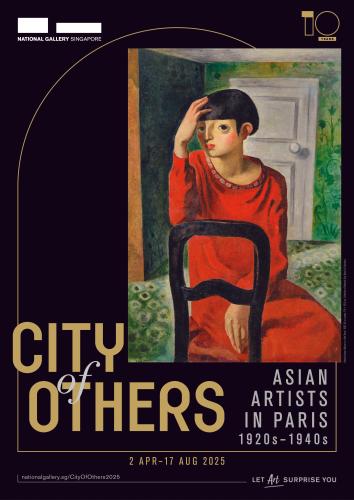Exposition « City of Others : Asian artists in Paris 1920-1940 »
par Peter Bloom

L’exposition « City of Others: Asian artists in Paris 1920-1940 », présentée à la Galerie nationale de Singapour jusqu’au 17 août 2025, met en lumière une dimension souvent peu explorée de l’histoire parisienne : les trajectoires artistiques d’artistes asiatiques ayant résidé dans la capitale au cours de l’entre-deux-guerres. Une thématique déjà abordée par les historiens Pascal Blanchard et Éric Deroo dans Le Paris-Asie (La Découverte, 2004), qui retraçait ces circulations artistiques et intellectuelles venues d’Asie et leur inscription dans le paysage parisien de l’époque. Cette période, marquée par l’émergence d’un esthétisme moderne et d’une culture en constante hybridation, constitue le cadre d’un riche dialogue artistique et intellectuel. Les œuvres présentées, réalisées par des artistes venus de Chine, du Japon, du Viêtnam, mais aussi d’Asie du Sud-Est et du Sud, s’articulent autour de six grandes thématiques, visant à offrir une lecture approfondie et plurielle de cette histoire. Véritables témoins de l’expérience des étrangers à Paris, ces œuvres s’inscrivent dans un contexte national encore structuré par des logiques raciales et coloniales, propres à l’après-Première Guerre mondiale. Pourtant, ces artistes trouvent leur place dans la vie culturelle parisienne et participent activement à l’évolution du paysage artistique local, en y introduisant des thématiques issues de leur propre histoire : l’Indochine coloniale, l’Exposition coloniale, l’environnement urbain ou encore les scènes du quotidien parisien. Peter Bloom, professeur d'études cinématographiques et médiatiques à l’université de Californie (Santa Barbara), propose en tribune cette semaine pour le Groupe de recherche Achac une lecture critique de l’exposition.
City of Others: Asian Artists in Paris, 1920s-1940s at the National Gallery of Singapore is a significant exhibition featuring comparative work by a wide array of artists from Asia in Paris during the interwar period. This show features artists from China, Japan, and Vietnam primarily, but also from Southeast and South Asian contexts integral to the shaping of a new aesthetic derived from Parisian internationalism. The exhibition demonstrates how categories of colonial difference were simultaneously upheld and transcended in the shaping of an expansive modernist aesthetic. Furthermore, this exhibition is especially pertinent within a current post-Cold War perspective given its emphasis on how non-Western aesthetics already informed colonial aesthetics in spite of an interwar exotic quality of presentational framing.
The “others” residing in Paris of the era were a relatively small population, but contributed significantly to an unfolding hybridized aesthetic. The show emphasizes the role of Vietnamese artists in particular, such as Lê Phổ (1907-2001), Mai Trung Thứ (1906-1980), and Nguyễn Phan Chán (1892-1984), but also features well-known Japanese and Chinese artists including Xu Beihong (1895-1953), Yun Gee (1906-63), Kanae Itakulla (1901-29) and his wife Sumiko (1908-34), Yen Shui-long (1903-1997), Yan San-lang (1907-95), among others. The work of Georgette Chen (1906-1993), a Chinese-born Singaporean who lived in Paris for many years, was also featured. There is a richness to the subtle approach to “otherness” that is presented that is not only within an idiom of figurative portraiture, but also incorporates sculpture, decorative arts, and abstract paintings. The work presented in the show was loaned from a wide array of Chinese, French, Japanese, Taiwanese, and US art institutions as well as private collectors demonstrating the expertise and ingenuity of the curatorial team led by Dr. Phoebe Scott.
The show itself is organized in five sections that includes “Workshop to the World” with an emphasis on Art Deco aesthetics, “Theater of the Colonies” with a geographic focus on Indochina and the 1931 colonial exhibition, “Spectacle and Stage” featuring films of theatrical presentations including dance and public performance, “Sites of Exhibition” featuring the work of Chinese artists appearing at the Jeu de Paume Museum, “Studio and the Street” focused on the depiction of street life with work by Tsuguharu Foujita (1886-1968) among others, and “Aftermaths” featuring the work of artists immediately after World War II when the so-called interwar School of Paris ended. In addition to photographs and a short film depicting scenes from the 1931 colonial exhibition, there is a significant presentation of the 1925 Paris International Exhibition of Modern Decorative and Industrial Arts that features the work of designers and artists from China, Japan, and Indochina.
While there is a rich historiography and iconography of French Indochina, the ingenuity of this exhibition is a comparative approach to Asian art within the terms of a Paris-centered context. It demonstrates how design aesthetics of the interwar era were more subtle in their reference to colonial paradigms of difference allowing for a significant degree of poetic license in the works that evolved from this defining era.
